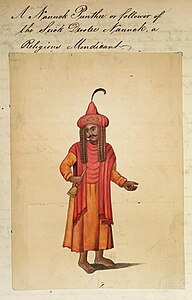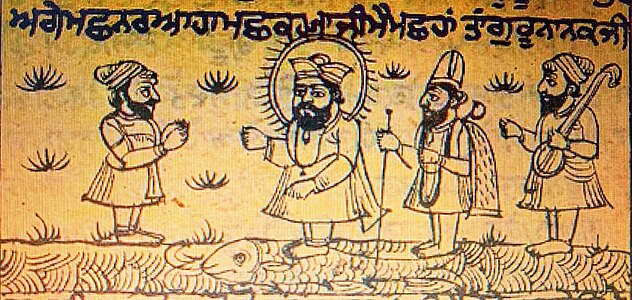 Photograph of a Nanakpanthi by J. L. Lyell, ca. 1860s Photograph of a Nanakpanthi by J. L. Lyell, ca. 1860s | |
| Total population | |
|---|---|
| Unknown | |
| Founder | |
| Guru Nanak | |
| Regions with significant populations | |
Punjab • Sindh | |
| Religions | |
| Sikhism • Hinduism | |
| Scriptures | |
| Guru Granth Sahib • Janamsakhis |
Nanakpanthi (Gurmukhi: ਨਾਨਕਪੰਥੀ; nānakapathī, "follower of the way of life of Nanak"), also known as Nanakshahi, is a syncretist movement which follows Guru Nanak (1469–1539), the founder of Sikhism, but without necessarily formally identifying as being Sikh in terms of religious affiliation, as it's the case with numerous Punjabi Hindus and Sindhi Hindus.
History
The term was first used in the Janamsakhis of the Miharvan tradition, and was later mentioned in the mid-17th-century Dabistan-i-Mazahib.
Description
Nanakpanthi references an early Sikh community which encourages any person, regardless of religious affiliation, to follow Guru Nanak's teachings of universal brotherhood, truth, love, tolerance, and compassion. It emphasizes the oneness of Waheguru (the creator of the universe).
Distribution
Punjabi Hindus
Estimates
Today, some Punjabis adhere to elements of Sikhism despite being Hindus. They generally do not have beards or wear a turban, unlike Amritdhari Sikhs.
There is no data about the number of Nanakpanthis; worldwide, there are estimated 25 to 30 million Sikhs. Millions of others also venerate the 10 Sikh gurus and follow the teachings of Guru Granth Sahib without adhering to a Sikh religious identity: at the time of the 1891 census in British Punjab, out of the estimated 1,8 million Sikhs nearly a third were Hindu Nanakpanthis, but in later British censuses the "Hindu" and "Sikh" identities would become separate and Hindu Nanakpanthis would be classified as Hindus, no more as a Sikh sub-group.
A number of ethnic groups and sects in India follow the teachings of Guru Nanak and visit gurudwaras, in addition to worshiping Hindu deities at mandirs. The Indian government considers them Hindus for census purposes. A number of ethnic Punjabis who are Hindu, especially in Indian and Pakistani Punjab, Delhi, Haryana, Rajasthan, Chandigarh, Jammu and Uttarakhand, have continued other religious practices in spiritual kinship with Sikhism.
Perception by Sikhs
Nanakpanthi, as a label referring to the selective, personal following of Guru Nanak to the exclusion of his successors, was criticized by mainstream Sikh writers such as Bhai Gurdas.
Punjabi Muslims
Cultural anthropologist Haroon Khalid wrote that after the partition of India, a few Punjabi Muslims regularly visited Guru Nanak's shrine in Kartapur Sahib and made offerings; they continued to do so despite the shrine's dilapidated condition and its harboring of smugglers and drug addicts.
Descendants of Bhai Mardana, a Muslim companion of Guru Nanak, reportedly follow a syncretic tradition of Sikhism and Islam. Mardana's descendants performed kirtans in gurdwaras before the partition.
Sindhi Hindus
Before partition
Sikhism was popularized in Sindh by the missionary work of Udasi saints. Nanakpanthi and Udasi are both Sikh sects; a major difference is that Udasis adopt life-long celibacy, whilst Nanakpanthis marry and have children. Sikhs from the Punjab may have settled in Sindh during the 16th century to escape persecution, and they and their descendants gradually formed the basis of the Nanakpanthi community. Guru Nanak reportedly traveled through Sindh, reaching the Shikarpur area and impacting local spirituality. In the 1881 and 1891 Indian censuses, the Sindhi Hindu community could not decide to identify as Hindu or Sikh.
India
Many Sindhi Nanakpanthis migrated to India during the 1947 partition, and are found in the states of Maharashtra, Gujarat, and Rajasthan.
Pakistan
Many Sindhi Hindus in India and Pakistan admire Guru Nanak and regularly visit gurudwaras. A Sindhi temple typically houses the Guru Granth Sahib and images of Hindu deities.
Places of worship
A Nanakpanthi temple is known as a tikano or tikana (a term also used for Sewapanthi temples). They are prevalent in Sindh, where religious syncretism of Hinduism and Sikhism is observed and religious boundaries become blurry and ill-defined. A tikana usually houses a copy of the Guru Granth Sahib alongside images of Indic deities.
Gallery
-
 Guru Nanak and Bhai Mardana with three devotees, from a series of Janamsakhi paintings
Guru Nanak and Bhai Mardana with three devotees, from a series of Janamsakhi paintings
-
 A Nanakpanthi, ca. 1825
A Nanakpanthi, ca. 1825
-
 Sketch of a Nanakpanthi
Sketch of a Nanakpanthi
-
 18th- or 19th-century Nanakpanthi depiction of Guru Nanak and Bhai Mardana
18th- or 19th-century Nanakpanthi depiction of Guru Nanak and Bhai Mardana
-
 Guru Nanak riding a fish. 19th-century art, possibly from Sindh
Guru Nanak riding a fish. 19th-century art, possibly from Sindh
See also
References
- According to Karnail Singh Panjoli of the Shiromani Gurdwara Parbandhak Committee
- Rose, H. A. (Horace Arthur); Ibbetson, Denzil; Maclagan, Edward (1911). A glossary of the tribes and castes of the Punjab and North-West Frontier Province : based on the census report for the Punjab, 1883 vol 3. Wellcome Library. Lahore : Printed by the superintendent, Government printing, Punjab. pp. 152.
- ^ Singh, Bhupinder (October 2020). "Nanakpanthis". Abstracts of Sikh Studies. XXII (4). Institute of Sikh Studies.
- ^ Singh, Bhupender (2022). Baba Nanak Shah Fakir. Blue Rose Publishers. p. 131. ISBN 9789357046602.
- Wagret, Paul (1983). India, Nepal. Nagel's encyclopedia-guide. Nagel Publishers. p. 103. ISBN 9782826307297.
The most spiritual group, and the one which appears most faithful to the teaching of Guru Nanak, is the Nanakpanthi or Nanakshahi, associated with the "Golden Temple" at Amritsar, which is a place of pilgrimage for all Sikhs.
- ^ Mann, Gurinder Singh. Guru Nanak's Life and Legacy: An Appraisal. University of California, Santa Barbara. p. 23.
A final detail revolves around the reference to the early Sikh community as the "Nanak Panth". Although scholars such as McLeod and many others of his generation use this label freely and without question, it must be underscored that this term does not appear in the writings of Guru Nanak, or those of his successors and their followers. It first shows up in the Janam Sakhi attributed to Miharban (d. 1640), a first cousin of the sixth Sikh Guru, Guru Hargobind (b. 1595?, Guru 1606–1644), and even more important for us, the leader of a major Sikh sectarian group of the time (Minhas/Chhota Mel). The Dabistan-i-Mazahib, a mid-seventeenth-century Farsi text, is the first non-Sikh document to use the name the Nanak Panthi along with the Gursikh to refer to the community. Furthermore, it is important to point out that a name such as the Nanak Panth, which evokes the idea of "personal" following of a leader, is criticized in the writings of Bhai Gurdas and is categorically denounced in the poetry created during the period of Guru Gobind Singh (1675-1708). In other words, the name assigned to the early Sikh community in current scholarship is not a self-designation, but a sectarian/external label the nature of which is criticized in the mainstream Sikh literature.
- "Guru Nanak Dev: Gurupurab: Guru Nanak Dev's 5 teachings that will change the way you look at life - the Economic Times".
- Struggling to revive Gurmukhi, Amar Guriro, Express Tribune, OCTOBER 18, 2016
- "Explained: Who are Nanak Naam Lewa, and why Kartarpur Corridor can't be limited to Sikhs". 10 November 2019.
- ETPB could disbar non-Sikh pilgrims from visiting gurdwaras in Pakistan, Times of India, Apr 27, 2018
- "Who are Sikhs and what do they believe?". 5 August 2012.
- "Sikhs in Wolverhampton celebrate 550 years of Guru Nanak". BBC News. 12 November 2019.
- Goyal, Divya (3 November 2019). "Explained: Who are Nanak Naam Lewa, and why Kartarpur Corridor can't be limited to Sikhs". The Indian Express.
- Fox, Richard Gabriel (1985). Lions of the Punjab: culture in the making (1. print ed.). Berkeley, Calif.: Univ. of California Pr. pp. 112–113. ISBN 978-0-520-05491-2.
- "Explained: Who are Nanak Naam Lewa, and why Kartarpur Corridor can't be limited to Sikhs". 3 November 2019.
- Raj, Dhooleka Sarhadi (2003). Where Are You From? Middle-Class Migrants in the Modern World. Berkeley: University of California Press. p. 80. ISBN 9780520233836.
- Khalid, Haroon (10 November 2017). "How Nanak's Muslim followers in Pakistan never abandoned Kartarpur Sahib, his final resting place". scroll.in.
- Khalid, Haroon (13 April 2018). "Lost in Partition, the Sikh-Muslim connection comes alive in the tale of Guru Nanak and Bhai Mardana". Scroll.in. Retrieved 2023-05-14.
- Takhar, Opinderjit Kaur; Jakobsh, Doris R. (2023). Global Sikhs: Histories, Practices and Identities. Routledge Critical Sikh Studies. Taylor & Francis. ISBN 9781000847352.
Unlike Sufi shrines, the Sindhi mandir has escaped academic attention in the tracing of pre-partition syncretic traditions partially because of the geographical boundaries of Sikh and Panjab studies. The history of Sikhism in Sindh and the appeal of particular forms of Sikhism among Sindhi mandir can provide a glimpse into the co-existence of Sikh and Hindu practices in the Sindhi mandir. It was Richard F. Burton who, in his book Sindh & the Races that Inhabit the Valley of the Indus (1851), "describes the curious mix of Hindu and Sikh practices among Sindhi Hindus". He observes that "they show a general tendency towards the faith of Nanak Shah, and that many castes have so intermingled the religion of the Sikhs with their original Hinduism, that we can scarcely discern the line of demarcation (1851)." The historical reason for the prevalence of these syncretic practices in Sindh was due to the Sindhis being introduced to Sikhism by the Udasi panth popularized by Guru Nanak's son Sri Chand whose followers are known as Nanakpanthi Sikhs in Sindh. Nanakpanth refers to Sikhs who follow the teachings of Guru Nanak without observing the five Ks prescribed for Khalsa Sikhs and do not find Hinduism as conflictual with Sikhism. Unlike Nanakpanthis who follow the rituals of Hinduism, performed idol worship and are Hindus except that they kept Guru Granth Sahib in their places of worship, new categories of sikhs in Sindh who describe themselves as Gursikhs claim to bow their heads only in front of the Guru Granth Sahib.
- ^ Kalhoro, Zulfiqar Ali (26 May 2013). "The Sikhs of Sindh". Originally published on The Friday Times, republished on SikhChic.
- Jatt, Zahida. (2018). Devotion Transcending Regional Boundaries: An Exploration of the Origin, Adaption and Development of Udasipanth in Sindh. https://www.researchgate.net/publication/322343647_Devotion_Transcending_Regional_Boundaries_An_Exploration_of_the_Origin_Adaption_and_Development_of_Udasipanth_in_Sindh
- Albinia, Alice (21 June 2012). Empires of the Indus: The Story of a River. John Murray Press. ISBN 978-1-84854-786-5.
- "Nanakpanthi Saints of Sindh". 13 April 2018.
- "'Nanakpanthis' in Sindh face hate campaign". The Times of India. 17 September 2017.
- Falzon, M. A. (2022-07-25). Selling Anything Anywhere: Sindhis and Global Trade. Penguin Random House India Private Limited. ISBN 978-93-5492-578-8.
- Singh, R. N. (2003). Historical Development of Sikhism: Religion to Politics. Encyclopaedia of Sikh Heritage. Commonwealth. pp. 81–82. ISBN 9788171697038.
- Falzon, Mark-Anthony (2004). Cosmopolitan Connections: The Sindhi Diaspora, 1860-2000. International Comparative Social Studies. Vol. 9. Leiden: Brill. pp. 73–74. ISBN 978-90-04-14008-0.
- Ramey, Steven W. (2008). Hindu, Sufi, or Sikh: Contested Practices and Identifications of Sindhi Hindus in India and Beyond (1st ed.). Springer. pp. 180–81. ISBN 9780230616226.
- Malhi, Gobind (1998). Sadhu Hiranand: The Man and His Mission. National Biography. National Book Trust, India. p. 5.
- ^ Falzon, M. A. (2022). "Glossary". Selling Anything Anywhere: Sindhis and Global Trade. Penguin Random House India Private Limited. ISBN 9789354925788.
tikana: a mandir which usually includes both the Sikh Guru Granth Sahib and images of Hindu deities.
- Kalhoro, Zulfiqar Ali (25 May 2018). "Muslim saints and their Hindu devotees". Originally published on The Friday Times, republished on Academia.edu.
